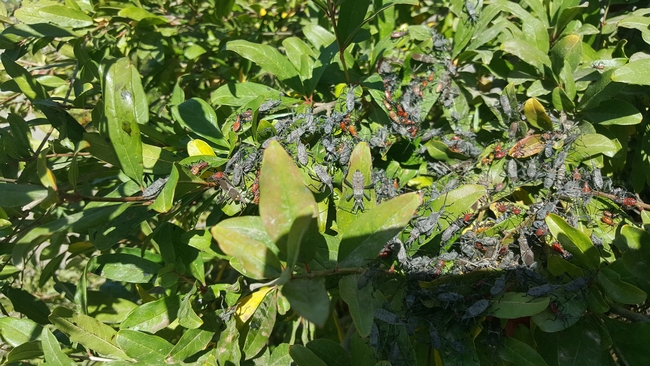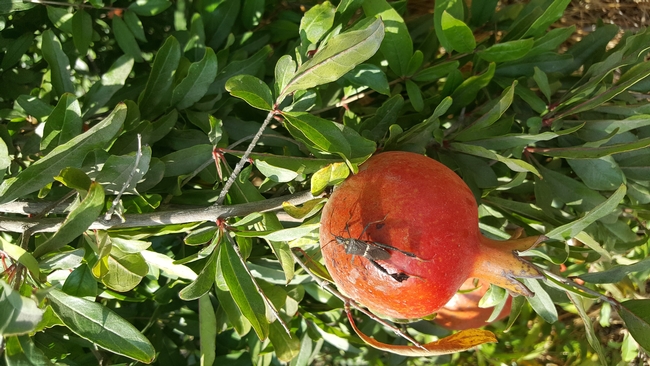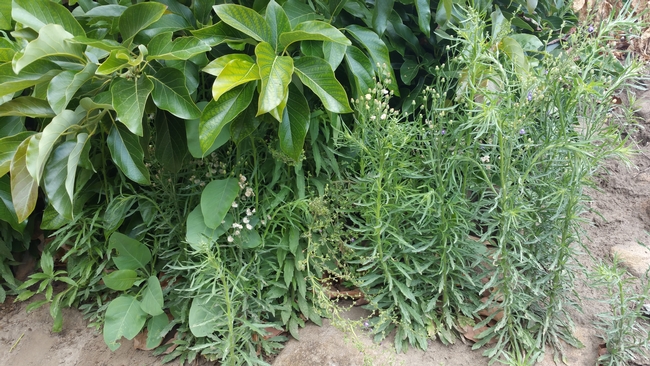
Posts Tagged: pomegranate
That Black Hearted Pomegranate
Pomegranate (Punica granatum) is a specialty crop now grown on more than 10,000 acres in California. Pomegranate production has increased for both fresh market and juice in the last several years, and with this increase, random internally rotted fruit has become more noticed. The outside of the fruit looks perfectly fine, but internally the fruit is rotted and the arils (the flesh covered seeds that are eaten and juiced) are black. Pretty disgusting. Some fruit recently has shown up at harvest and the grower was unaware of the problem until the fruit was opened by a customer. The only difference between good fruit and affected fruit is that the blackhearted fruit is a bit lighter in weight. The absence of external symptoms makes the diagnosis of the disease very difficult, and consumers encountering the disease may change their perception of the pomegranate's many health benefits.
Initially, it was thought that the disease was caused by various fungi that can decay only the arils. However work by Themis Michailides from UC Kearney REC has shown that after inoculation of pomegranate flowers and developing fruit that the main cause of black heart is Alternaria spp. These fungi are very abundant in nature and cause diseases in a multitude of crops. Another fungus that is also isolated from pomegranate with black heart is Aspergillus niger. However, the decay caused by A. niger is softer than that caused by Alternaria and results in exuded juice. In addition, another major difference between black heart caused by Alternaria spp. and that caused by Aspergillus is that the latter decays both arils and rind of fruit and frequently symptoms reach the outer surface of fruit, which helps in the diagnosis of the disease. Inoculations with Alternaria spp. reproduce the typical symptoms of black heart (internal decay of the arils without any external symptoms).
Inoculations periodically with Alternaria spp. showed that most of the infections occur at bloom time and that spores of the fungus that are introduced into the fruit (puncturing from thorns, hemipteran feeding like aphids and stink bugs, or cracking) can result in black heart. The current research focuses on the identification of the various species of Alternaria that cause black heart, the understanding of the infection process, and the development of procedures to manage the disease.
Alternaria alternata and related species commonly occur on plant surfaces and in dying or dead tissues of plants. The pathogens overwinter on plant debris in or on the soil and in mummified fruit. The spores are airborne and can be carried to the flowers with soil dust. Infections may also start from insect and bird punctures on fruit. Research in the San Joaquin Valley showed that the petal fall stage seems to be the most susceptible stage when most of the infection occurs. However, infection can occur throughout the long bloom and fruit development periods.
Estimated losses are usually less than 1% but can be up to 6%.
So how does a grower reduce black heart? Fungicide coverage has been a problem for bloom fungicides, but Michailides has shown some promising new materials. Good orchard management practices, such as dust control and sanitation (removal of old fruit and dead branches), may reduce the incidence of the disease. Infected, healthy-appearing fruit may be dropped to the ground by gently shaking the tree at the time of harvest. Avoid water stress and overwatering that may result in fruit cracking.
Thorough sorting and grading of pomegranates for discoloration and cracking can help avoid packing diseased fruit.
See the Themis' slide show:
http://ucanr.edu/sites/pomegranates/files/134012.pdf

blaCK HEART POMEGRANATE
Leaffooted Bug Alert
0University of California Cooperative Extension Area-wide IPM Advisor, Kearney Agricultural Research and Extension Center, Parlier, CA
Leaffooted Bug Populations in Ventura County - 2017
Cold winter temperatures can reduce populations of leaffooted bug, Leptoglossus zonatus (Dallas), by ~50 to 80%. But unfortunately, it takes a cold year much like occurred in January of 2007 when daytime temperatures remained low and nighttime temperatures reached about 20° F for several hours. In other words, ouch for the citrus crop. Fall and winter temperatures of 2016 / 2017 were ideal for leaffooted bug and the 2017 growing season started out with large populations. I need to add that we do not fully understand if the wet winter positively affected populations - it certainly did not have a negative impact. Moreover, it appears that leaffooted bug populations going into later 2017 will be very large.
Monitoring and managing leaffooted bug presents an IPM challenge. In the fall between September and mid-November, the species produces a full generation; certainly, on pomegranate and although I have not observed it, also on desert willow. In most years, adults move from those host plants by late December to protected overwintering sites such as Mediterranean fan palm and Italian cypress trees; and perhaps citrus. In early March leaffooted bug leave overwintering sites to feed on what happens to be available at the time. In the San Joaquin Valley and the Sacramento Valley region it is almonds and pistachio. In other parts of California, where those nut crops are not available, citrus may be an important host crop. In Louisiana, for instance L. zonatus can cause considerable economic damage on satsuma mandarins, however in California the species has not been reported as a serious pest on any of the citrus cultivars.
The IPM challenge is that we do not have an effective monitoring tool to detect the bug when they leave overwintering sites. And moreover, once leaffooted bug is detected, no economic threshold exists , and pyrethroids offer the best management option – not necessarily the best IPM option.
Given the importance of pomegranate in the life cycle of leaffooted bug, PCAs and growers need to concentrate monitoring efforts on that crop during September through October, especially focusing on unmanaged orchards and hedgerows. If populations are found they will consist mainly of immature stages and there are two management options, clothianidin and pyrethrins. The caveat is that those compounds have only contact activity; coverage must be good and the insecticides will likely not have a great impact on adults because they will spook and fly away before being sprayed. Two organic compounds, pyrethrin (PyGanic) and Beauveria bassiana Strain GHA (BotaniGard) can also be effective. But again, those compounds have no residual activity so the spray must contact the bugs to be effective.
Insecticide use should occur only if monitoring indicates the presence of leaffooted bug and/or its feeding damage. Apply insecticides only after considering the potential risks of the compound to beneficial organisms, including bees and biological control agents, and to air or water quality. For more information on these topics please consult the UC IPM Pest Management Guidelines for Almonds at http://ucipm.ucanr.edu > Agricultural pests > Almond
(Ben: This insect became prominent in Ventura in 2015. Kris was minding his own business when he saw this bug traveling at 50 mph down the road.
//ucanr.edu/blogs/blogcore/postdetail.cfm?postnum=19184)
|
Fig. 1. Aggregation of leaffooted by on pomegranate in early October of 2016. The aggregation is comprised mostly of fifth instar. |
|
Fig. 2. Adult leaffooted bug on pomegranate in Ventura County, September 8, 2017. |
Pomegranates with a Black Heart
Pomegranate (Punica granatum) is a specialty crop now grown on more than 10,000 acres in California. Pomegranate production has increased for both fresh market and juice in the last several years, and with this increase, random internally rotted fruit has become more noticed. The outside of the fruit looks perfectly fine, but internally the fruit is rotted and the arils (the flesh covered seeds that are eaten and juiced) are black. Pretty disgusting. Some fruit recently has shown up at harvest and the grower was unaware of the problem until the fruit was opened by a customer. The only difference between good fruit and affected fruit is that the blackhearted fruit is a bit lighter in weight. The absence of external symptoms makes the diagnosis of the disease very difficult, and consumers encountering the disease may change their perception of the pomegranate's many health benefits.
Initially, it was thought that the disease was caused by various fungi that can decay the arils. However work by Themis Michailides from UC Kearney REC has shown that after inoculation of pomegranate flowers and developing fruit that the main cause of black heart is Alternaria spp. These fungi are very abundant in nature and cause diseases in a multitude of crops. Another fungus that is also isolated from pomegranate with black heart is Aspergillus niger. However, the decay caused by A. niger is softer than that caused by Alternaria and results in exuded juice. In addition, another major difference between black heart caused by Alternaria spp. and that caused by Aspergillus is that the latter decays both arils and rind of fruit and frequently symptoms reach the outer surface of fruit, which helps in the diagnosis of the disease. Inoculations with Alternaria spp. reproduce the typical symptoms of black heart (internal decay of the arils without any external symptoms).
Inoculations periodically with Alternaria spp. showed that most of the infections occur at bloom time and that spores of the fungus that are introduced into the fruit (puncturing from thorns, hemipteran feeding like aphids and stink bugs, or cracking) can result in black heart. The current research focuses on the identification of the various species of Alternaria that cause black heart, the understanding of the infection process, and the development of procedures to manage the disease.
Alternaria alternata and related species commonly occur on plant surfaces and in dying or dead tissues of plants. The pathogens overwinter on plant debris in or on the soil and in mummified fruit. The spores are airborne and can be carried to the flowers with soil dust. Infections may also start from insect and bird punctures on fruit. Research in the San Joaquin Valley showed that the petal fall stage seems to be the most susceptible stage when most of the infection occurs. However, infection can occur throughout the long bloom and fruit development periods.
Estimated losses are usually less than 1% but can be up to 6%.
So how does a grower reduce black heart? Fungicide coverage has been a problem for bloom fungicides, but Michailides has shown some promising new materials. Good orchard management practices, such as dust control and sanitation (removal of old fruit and dead branches), may reduce the incidence of the disease. Infected, healthy-appearing fruit may be dropped to the ground by gently shaking the tree at the time of harvest. Avoid water stress and overwatering that may result in fruit cracking.
Thorough sorting and grading of pomegranates for discoloration and cracking can help avoid packing diseased fruit.

blackheart pomegranate
Weed Control in Subtropical Tree Crops
Control of weeds has always been a major economic cost in subtropical fruit production because of favorable climate that allows for weed germination and year-round growth. The use of chemical weed control has increased dramatically due to labor costs, equipment costs, product costs and availability, the shift to more narrowly spaced tree rows, and installation of low volume irrigation systems that prohibit the operation of mowing or tillage equipment under the tree canopy area (Futch 2001).
However finding herbicides that are labeled for certain subtropical crops can be a bigger challenge. UC Weed Science has updated the Subtropical Crops herbicides usage chart for California growers (Fig. 1 Attachment below). It also seems that preventive programs are most frequently overlooked as a method of weed control. Preventive programs entail the use of such practices as sanitation, spot spraying, or hand labor to prevent the source of weed infestation (seed and/or vegetative) from widespread dissemination throughout a given area. By removing the undesirable weed species prior to seed development, dissemination by wind or mechanical transport on equipment can be effectively delayed.
Weed control programs will vary from location to location within the state and can even vary within a given site based upon specific conditions such as soil type, variety, method of herbicide application, and the presence of specific weed species.
Before herbicide application, growers should survey the grove and determine the stage of growth and type of weeds for that given location. Many products do not provide control of emerged species, thus requiring the application of more than one product to provide both preemergence and postemergence protection (Futch 2001). Rotation of soil-applied herbicides should also be considered to prevent the buildup of resistant annual and perennial weeds. The resistant species may not be evident initially; however, if the same herbicide and cultural program is maintained, over time their populations may build up until they infest the entire grove and become the dominant weed species (Jordan et al 1992).
Herbicide damage to foliage and fruit has also been noted when herbicides were applied under windy conditions or use of improper equipment allowed the materials to contact areas other than the weeds or soil. Please make sure to follow the label's direction and use caution.
Attached below is a chart listing herbicides registered for avocado, citrus, date, kiwi, fig and pomegranate.
Figure 1. Herbicide Registration on CA Subtropical Crops
Herbicides Registered for Citrus, Avocado and a Few Other Subtropical Tree Crops
Here is an updated guide for herbicides that are registered for citrus, avocado and a few other tree crops.

herbicides registered for subtropicals




